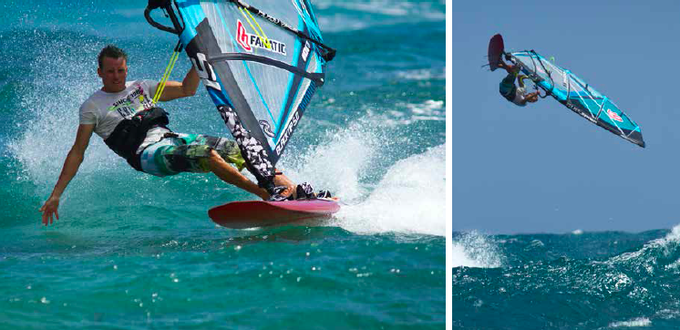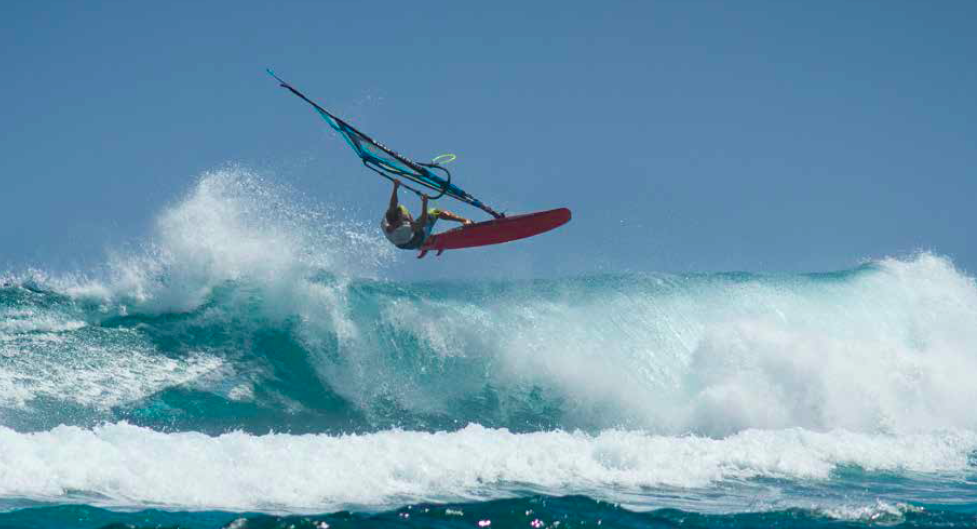The Stubby…
Last Autumn we heard of a brand new innovation from Fanatic… a board that was top secret and a completely different style to what we’ve seen in production before. Now this board – The Stubby – has been officially released (if you haven’t seen it check out more here) by Fanatic.
Here you can now read the full story, from last years wave annual, of how this board was developed; Adrian Jones asks the questions whilst Klaas Voget provides the insight…

What is the thinking behind this board and how did the idea come about?
If you look at the board, it’s obvious that the idea comes from surfing.
There has been a lot of exploring with more parallel rail concepts in the surfing world; Firewires’ Vanguard is probably the most popular example. Sebastian (Wenzel) and I were looking into these concepts for quite some time, but the actual input for our first board came from inside the Boards and More group. When I was in Cape Town last January, I was talking to the R&D Team of North Kiteboarding and the guys showed me their latest prototypes and told me what they felt like. Their excitement about them gave us the initial push to actually build a windsurfing board with a similar idea.
First impression is, that it gets going very early and feels very fast and free.
The much wider tail and nose gives a lot more stability to the board, planing or non-planing, while the straighter rails give stability in the turns, as they maximise the effective rail line to its functional length. The straighter water flow around the board produces less drag compared to a rounder outline, which increases the speed. The nose is almost as if it’s been ‘chopped off’, as the area that would continue for a regular pointy nose doesn’t have much function, but would simply give more length and weight to the board. Basically, the idea behind this nose is to reduce the board’s length to its functional minimum and reduce the swing weight of the nose area. You can feel this in spinning moves and turns, that the board is more reactive and changes direction very fast.
In windsurfing we have completely different forces working on the board and fins compared to surfing. The board doesn’t just have to work on a wave; it also has to perform in a straight line and in jumps. That’s why you cannot just scale up a surfboard with this concept. Sebastian and I started working on it right after that Cape Town trip and after a lot of brainstorming we finally had the first proto in the water in Maui at the end of March – and this first test left such an impression that we kept the R&D totally secret from there.
It actually took one change to the fin setup and 15 minutes of testing until I said to Sebastian that this is one of the most fun boards I’ve ever tried.

How many prototypes have you built?
We have built three prototypes so far, but before going into the second one we made changes to the first proto step-by-step. As we were starting from scratch, we built the board a bit differently to normal, so that I could easily change and adjust things. It actually took one change to the fin setup and 15 minutes of testing until I said to Sebastian that this is one of the most fun boards I’ve ever tried.
How did you manage to test it without anyone seeing it? Where did you do the testing?
For the first test, Sebastian, Dani (Aeberli) and I went to Camp One on Maui and took the board to the beach in a boardbag. As it was a good day in Hookipa and all the brands were shooting there, hardly anyone was around, so we had an hour for ourselves with just a few boards to compare and a bag full of fins. We instantly knew we were onto something special. After the Maui shoot I went for a test trip with that board to a secret spot where nobody would see me testing. I scored a few days in different conditions with only one local around. He was so impressed with what he saw, that he asked me to tell him when this board would be out, so he could get one. After that trip, I’ve made some changes to the tail and fin set-up and then scored a few sessions at a quiet beach in Denmark before going to the Canaries for the PWA events. I had the board there to test with Victor, but every time we looked for a quiet moment to test, some of the other pros or someone with a camera showed up. In the end Craig (Gertenbach) and I sneaked in some testing on the board early morning in Tenerife a week after the PWA event. After that we made two more protos; Victor and I have had them all in Denmark with us and had some good results.

How does it sail and what would you say are its strengths?
First impression is, that it gets going very early and feels very fast and free. The board sits on the water comfortably and the stance – with the back foot basically right on the tail – feels natural and not as weird as you would expect. As the tail is so wide, we use a fairly large centre fin, which gives an incredible upwind performance and lets you point at an angle you’ve never sailed before on a waveboard. The short nose doesn’t catch, as it’s just high and wide enough to be always out of the water or lift you out after the turns.
You can snap it around like a little skateboard, but still have such a good balance and easy planing.
These abilities alone make it very hard to beat for cross-onshore conditions, but even the turn itself has something special. As the tail is so wide, you’d expect it to be difficult to turn, but as your back foot is located right on the tail, you can actually turn it incredibly easily. The bottom turn seems effortless and very controlled as you have a lot of rail in the water. So far we’re still working on getting it to turn more reactive to changes once the line is set, but I think that’s just a matter of finding the perfect fin set-up and placement for it to make that work also. When you hit a breaking lip with this board, it has an incredible tail release and lift that throws a huge amount of spray. Wave moves like takas, backside 360’s etc. feel very easy and fast, as the wide tail with this stance offers a huge amount of ‘pop’ and the short length just rotates faster than a regular board.
So, is it just for specialist conditions or advanced riders?
No, not at all, I feel that the exceptional thing is its ease of use, especially in less than ideal conditions. You can snap it around like a little skateboard, but still have such a good balance and easy planing.
 Specifically, what do you think it offers to the intermediate wave sailor?
Specifically, what do you think it offers to the intermediate wave sailor?
I think it’s easy going, speed, balance and upwind performance are features that will also impress sailors with an intermediate level. We’re just playing with different lengths and sizes right now to see if we can make them even easier.
What’s it like for jumping? Surely that short, wide nose isn’t the best for jumping?
Jumps usually start with the speed you have when you hit the lip. As the board gets going very fast and has quite a bit of area for the wind to lift it, the jumping performance is actually quite good.
It must have some drawbacks over a traditionally shaped board?
So far the things we’re still working on to improve are the open face turns and the faster reactions to a change of direction in the bottom turn – especially when it comes to more down-the-line riding. I think we’ll get there pretty soon by working on the fins; it’s a mission to test and keep things secret at the same time nowadays. Also, we still have to try more different rocker lines and bottom shapes with this concept and also more pure down-the-line wavesailing. But so far in the more ‘Euro’ conditions we tested the board in, it just feels so much fun!
With it being wider, do you sail a smaller board?
Volume-wise, the boards are not so big and they are actually a bit narrower than a standard board. The super wide tail in particular makes the board feel bigger than you’d expect, looking at the width, length and volume.
Does that wide, low nose catch easily?
I think we just hit the sweet spot with our first protos. It’s a matter of finding the right rockerline to lift the nose just high enough not to catch, but still be low enough to offer the planing abilities. I got thrown over the handlebars a few times in the beginning, as I had the mastfoot too far forward. But after I found the right place for it, that doesn’t happen anymore.
What fin set-up does it work best with?
At the moment we have a Custom 18cm MFC centre-fin and 12cm side-fins in the 77litre proto and that works great. Yesterday I tested a smaller version as a quad and that also left a great impression – but also here we need to do more testing, as the board is so different, the fins need to be too. I have already the next set in the board and a couple more lined up in my fin bag.
Do you think this board style will spell the end for traditionally shaped boards? Is it that good?
That’s hard to say. When I look at surfing, the majority in the WCT is riding classic short boards in the contests we watch. But I’ve seen many surfing pros training on these concepts as well and some used it in competition. I think most of the guys know their classic boards so well that it’s always a risk to go for something so different in the contest – also the surfing pros ride a lot of perfect waves – and that’s where we’re still working on improvements.
Will we see this board going into production in the near future? If so, in what sizes?
Right now we’re looking for a spring release in two sizes – you just have to wait a bit more for details 😉
Do you have a name for it yet?
The working name is the Stubbster. But when I showed it to a good friend he called it the Hammerhead. Not sure what fits into the Fanatic family best – I think we have to discuss that still.
Who should buy it?
Everyone who loves wavesailing and doesn’t live in Punta Preta! I think I’m going to use these boards a lot in most of the places I sail in; from the Canaries to Denmark and the Baltic Sea – maybe even in Hookipa. I’m looking forward to trying it there once we can go public!





